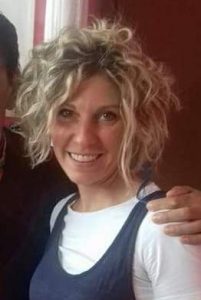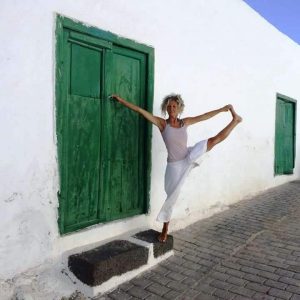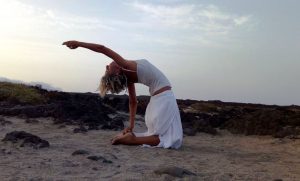Maintaining fluidity in the flow of life.
by Odaka Yoga Francesca Cassia & Roberto MIlletti www.odakayoga.com
Yoga and osteopathy derive from a homeopathic vision of the human being: both are seeking fluidity. A fluid body, drained, with ” working lympathic system brings upon wellness and a prefect synchronicity of mind and body.
To move with awareness and presence allows for the fluidity of the organism that is always moving and changing, increasing our vital energy (prana) that is essential to our physical and meant a wellbeing. Every human being is created to maintain a natural state of balance (health), but this notion is usually difficult to apply due to various factors tied to our lifestyle, physical trauma and our emotions.
MANIPULATION
The osteop”thic techniques of manipulation, which are integrated in a yoga practice, with conscious movements of the body that are founded on breathing, create harmony and allow for our system to remove blocks from emotional or physical tension, in order to be able to easily reach homeostasis and the eventual pre-existing dysfunction leaves space for a “physiologic” l self-healing.” The potential self-healing may be reawakened from specific actions that act upon our muscular, internal, cranial, hormonal and emotional system.
The tissue system (complex system of tissue connection) and the bodyʼs meridian system (chAnnels of energetic connection coincide with A yogic and osteopathic practice, which favor the attainment and the maintenance of a global state of balance and physical and mental vitality.
THE POINT OF CONTACT
In OdAka” Yoga, by using a certain rhythm and inflection in the sequence, there comes forth a certain peculiar flow of internal energy (prana); it is possible to experiment and point out the theoretical principles and the existing connections between the two philosophies through the following:
___ the shaking of the tailbone
this reawakens the prana and allows the kundalini energy to spread throughout the body while ascending to the cranium as explained by William Garner Sutherland;
___ the movement of the waves
that deeply connects the cranial area and the tailbone area, combined with listening to the natural breath, goes to determine the right fluidity in terms of
energy, fluctuation mechanisms that in osteopathy is defined as “tide”, meaning the back and forth fluid motion;
____ liquify your limits
flowing like water in its multiple forms, allows for the understanding of how to be in the “flow.” A state in which one becomes aligned with his/her most genuine self, our intentions and the environment that surrounds us. In doing so it is possible to experience a sense of freedom that transforms every obstacle and limitation to discover new “forms” within ourselves.
IN DEPTH ANALYSIS
William Garner Sutherland defines “the Breath of Life” the Mechanism of Primordial Breathing with microfluctuations of the cranium that spreads throughout the body through the cerebrospinal fluid, through the membranes that envelop the brain and the bone marrow of the spine or rather the crani”l system.
“A true and sincere act that belongs to me is one that, when finished, makes me happy. I see myself, I feel comfortable regardless of my insecurities.”
In osteopathy, fluidity is understood as elimination of the cornerstone derived from tension in order to reactivate the normal physiologic”l state of the various apparatus.
______ spiral concept:
the concept of a spiral is the idea of a never-ending movement; an open and unlimited movement. The spiral is energy and produces energy; in breathing, energy and movement move in unison in a type of vortex following the same form in nature and that of the human body. The spiral in osteopathy has beginnings in the axial strip that encircles the dura mater that then extends into the other strips that unifies the muscles, joints and gut.
________ the Ultimate Warrior movements:
the combination of personal defence techniques, functional movements and yoga poses allow the body to move slowly and smoothly during the transition from one position to the next involving, simultaneously, the entire kinetic chain of movement. The poses are done safely and the practice also has an effect on an emotional level.
In osteopathy, the connection between the body and emotions happens through the dural tube that is itself activated by the PNEI System (Psycho Neuro Endocrine Immune).
“Do not resist; do not create suffering. Let reality be reality. Let things flow naturally forw:rd; in some way this is what it likes.”
L:o Tzu
The balance of the PNEI System guarantees psycho-physic”l wellbeing, understood as our minds, our neurological system, endocrine system and immune system all working well.
Two Precious Tools
It is important to have energy move freely and consciously. To know how to distribute oneʼs emotional flow inside and outside oneself. Flexibility and flowing allow individuals to build relationships that are soft and elastic in order to become better at growth and transformation. Transform and let go…. Maintain the flow in the ebb and flow of life. One must keep the mind in a continuous state of fluidity, slightly meditative, characterised by calm movements, slow and centered and by a general sense of joy and satisfaction when confronted with life, the present moment, since the mind can become fixated on something means that the flow has been interrupted and there is no free behaviour.
Evolving
This involves new format, a fascinating project that allows for a journey mainly of experience and geared toward the understanding of Yoga and Osteopathic techniques. The intention is to bring back the old tradition of communication and expression of body language where the body is lived as a result of an evolving process in flux: live the moment with trust in the bodyʼs intelligence and the listening to oneself (and of the other). This generates empathy and frees all creative resources. The sharing and the transmission of knowledge accompanies people to enter into a space of listening openly and to reconnect with the bodyʼs needs. To express and affirm oneʼs originality, one must start with unique movements because they have origins in experience and individual awareness.
“Flow with whatever is happening and free your mind. Be centered accepting whatever you are doing. This is the ultimate.”
Chuang Tzu
Experience :as a Base
Practical experiences stimulate our bodiesʼ emotions during movement making us aware of our internal and external world.
The temporal dimension that has been slowed down allows one to find a functional and organic movement that respects the bodily structure and the intimate relationship with the earth, space, others, allowing to revive our motor
skills, which is a part of human evolution.
This technique allows for a lesson in listening to messages from the body, “a place of resources and potential, experimenting with the birth of movement beginning with basic elements of openness to bring oneself into the space. The psychomotor benefit are many and very well valued. But, the heart of the method beats around the body. Mannerisms are listened to, “along with posture and immobility in order to stimulate the forgotten parts, starting with movement, can create a positive change in psychophysical wellbeing.
While practicing one can experiment with the fact that change is at hand: the body is key to this journey and the road to a life full of marvellous encounters. The proposal is simple for everyone and the experience happens exclusively through action not words because the body does not know how to lie. The finding is geared towards the discovery of honest movement and so extremely unique. During the course of an encounter, music and movement serve as a guide to support the union of Yoga and Osteop”thy. A synergetic union, when intermixed, that mutually enriches.















